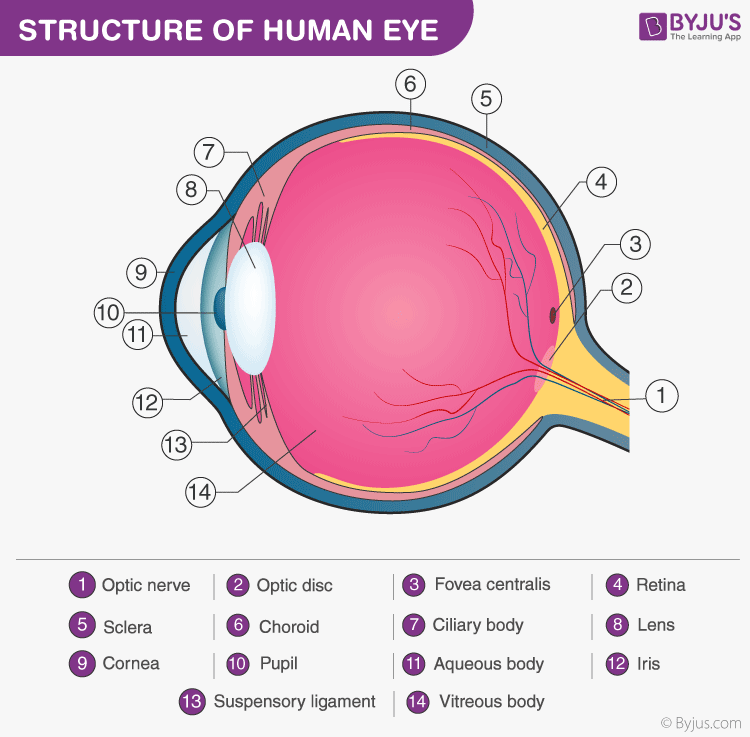Structure of the eye is essential to understand as it one of the important sensory organs in the human body. It is mainly responsible for vision, differentiation of colour (the human eye can differentiate approximately 10 – 12 million colours) and maintaining the biological clock of the human body. The human eye can be compared to a camera as both functions by gathering, focusing, and transmitting the light through the lens for creating an image of an object.
Table of Contents

Human Eye Diagram: Contrary to popular belief, the eyes are not perfectly spherical; instead, it is made up of two separate segments fused together.
Explore: Facts About The Eye
To understand more in detail about our eye and how our eye functions, we need to look into the structure of the human eye.
Structure and Functions of the Human Eye
The human eyes are the most complicated sense organs in the human body. From the muscles and tissues to nerves and blood vessels, every part of the human eye is responsible for a certain action. Furthermore, contrary to popular belief, the eye is not perfectly spherical; instead, it is two separate segments fused together. It is made up of several muscles and tissues that come together to form a roughly spherical structure. From an anatomical perspective, the human eye can be broadly classified into the external structure and internal structure.
The External Structure of an Eye
The parts of the eye that are visible externally comprise the external structure of the eye.
These include the following:-
Sclera: It is a tough and thick white sheath that protects the inner parts of the eye. We know it as the ‘White of the eye’.
Conjunctiva: It is a thin transparent membrane that is spread across the sclera. It keeps the eyes moist and clear by secreting small amounts of mucus and tears.
Cornea: It is the transparent layer of skin that is spread over the pupil and the iris. The main role of the cornea is to refract the light that enters the eyes.
Iris: It is a pigmented layer of tissues that make up the coloured portion of the eye. Its primary function is to control the size of the pupil, depending on the amount of light entering it.
Pupil: It is the small opening located in the middle of the Iris. It allows light to come in.
The Internal Structure of an Eye
The internal structure of the eye includes the following parts:
Lens: It is a transparent, biconvex, and an adjustable part of an eye. The lens with the help of the cornea refracts light focused on the retina, therefore creating images on it.
Retina: It is the layer present at the back of the eye where all the images are formed. It is the third and inner coat of the eye which is very sensitive towards the light because of the presence of Photoreceptors. The retina functions by converting the light rays into impulses and sending the signals to the brain through the optic nerve.
Optic nerve: It is located at the end of the eyes, behind the retina. The optic nerve is mainly responsible for carrying all the nerve impulses from the photoreceptors to the human brain, without which vision would not be possible.
Aqueous Humour: It is a watery fluid that is present in the area between the lens and the cornea. It is responsible for the nourishment of both the lens and the cornea.
Vitreous Humour: it is a semi-solid, transparent, jelly-like substance that covers the interior portion of the eyes. It plays an important role in maintaining the shape of the eye and also causes refraction of light before it reaches the retina.
Briefly explain the structure of the human eye.
The human eye is a roughly spherical organ responsible for perceiving visual stimuli. It is enclosed within the eye sockets in the skull and is anchored down by muscles within the sockets.
Anatomically, the eye comprises two components fused into one; hence, it does not possess a perfect spherical shape. It is classified based on two aspects, namely external and internal components. External components include structures which can be seen on the exterior of the eye, and internal components include structures present within.
External components include:
- Sclera
- Conjunctiva
- Cornea
- Iris
- Pupil
Internal components include:
- Lens
- Retina
- Optic nerve
- Aqueous Humour
- Vitreous Humour
What are the external structures of the eye?
The external structures of the eye include:
- Sclera
- Conjunctiva
- Cornea
- Iris
- Pupil
What is the function of conjunctiva?
Conjunctiva lubricates the front surface of the eye. It also protects the eyes from debris, dust and infection-causing microorganisms.
What is the function of the iris? How many layers does it have?
The iris regulates the amount of light entering the eyes by controlling the diameter and size of the pupil.
The iris consists of two layers:
- Stroma, the front pigmented fibrovascular layer
- Pigmented epithelial cells.
What are the internal structures of the eye?
The internal structures of the eye include:
- Lens
- Retina
- Aqueous humour
- Optic nerve
- Vitreous humour
Comments
Post a Comment